Large base. Dimensions and application. Pin base B
Types of light bulbs:
Incandescent lamp:
An incandescent lamp is distinguished by low price, but also a low number of operating hours, which is 1000 hours. Over time, the lamp filament migrates, which affects its brightness. Light transmission is 90%, the emission spectrum is close to the color of the sun. The vast majority of incandescent lamps are produced with E14 (thread diameter 14mm) and standard E27 (27mm thread diameter) bases.
They can also be produced in transparent and frosted glass.
Reflector incandescent lamp:
Unlike simple lamps incandescent and reflector lamps have a silver-plated surface. This reflective surface allows you to control the flow of light in the desired direction and create directional lighting.
They are produced with E14 (thread diameter 14mm) and E27 (thread diameter 27mm) bases. The most popular types of such lamps areR50, R63, R80, where the numbers indicate the diameter of the lamp itself.
Halogen lamps:
The light transmission of such lamps is close to 100%, and the service life is close to 4000 hours of operation. The scope of application of such lamps is very diverse. Thanks totreatment with iodine or bromine vapor, metal vapor does not deposit on the bulb, which allows it not to lose its lighting characteristics throughout its entire service life and allows for an increase in light output by 20-30 lumens/watt, as opposed to 12-15 lumens/watt for a conventional incandescent lamp with a gradual decrease luminous flux.
The sockets of such lamps are marked G9, G4, G5.3, R7Sххх, GU10. Where the numbers indicate the distance between the pins in mm.
Base G4 - used in decorative design And spotlights. The service life of lamps with this base is more than 2000 hours.
Base G5.3 - used in lamps designed for a voltage of 12V, and is connected to a 220V network through a special transformer.
The base R7Sххх is a base with a recessed contact. Lamps with such a base are used in lighting installations with high luminous flux intensity. Such lamps are used in the network alternating current 220V, 50Hz. The designation xxx uses the numbers 78, 118 - which indicates the length of the lamp in mm.
Base GU10 - have thickenings at the end of the contacts and are connected with a rotary movement to the cartridge. These lamps are used with GU socket10 in AC 220V.
Energy-saving lamps:
An energy-saving lamp is a compact fluorescent lamp, suitable instead of incandescent lamps chambered for E14, E27. Which allows without special difficulties in replacing a lamp with short term service for a longer period, about 8000 hours. At the same time, the very name of such lamps clearly expresses savings on energy consumption. They produce 50-60 lumens per watt of energy, which creates 5 times more light per unit of wattage compared to conventional incandescent bulbs. Light temperature is indicated in Kelvin (K).
difficulties in replacing a lamp with short term service for a longer period, about 8000 hours. At the same time, the very name of such lamps clearly expresses savings on energy consumption. They produce 50-60 lumens per watt of energy, which creates 5 times more light per unit of wattage compared to conventional incandescent bulbs. Light temperature is indicated in Kelvin (K).
Below 3300K - white, warm light.
3300-5000K - neutral light
Over 5000K - cold light
But another advantage is the production of such lamps with wide choice types of sockets, in addition to E14 and E27, such lamps are also available with GU10, G9, GU5.3, G4, GU4.
Base GU10 - have thickenings at the end of the contacts and are connected with a rotary movement to the cartridge. Such lamps with a GU10 base are used in a 220V AC network.
G9 socket - designed for operation in 220V AC mains, used in decorative lamps.
Base GU5.3 - used in lamps designed for a voltage of 12V, and is connected to a 220V network through a special transformer.
GU4 base - used in lamps designed for a voltage of 12V, and is connected to a 220V network through a special transformer.
Base- this is an element electric lamp , necessary for fastening the lamp in the socket, as well as for supplying electric current to the lamp. The base is made of metal, sometimes ceramic. It has parts of the lamp inside (electrodes, filaments), and contacts outside.
IN various lamps are used different types sockets, only the lamp with a suitable base is installed in each socket. When buying a lamp or choosing a lamp for it, you need to pay attention to the lamp base used in the lamp.
There are many types and subtypes of socles. 2 main groups: pin, threaded. The most common is a threaded (screw) base.
The first letter in the base marking determines its type:
- E - threaded plinth Edison;
- G- pin base;
- R- base with recessed contacts;
- B- pin base (bayonet);
- S- soffit base;
- P- focusing base;
- T- telephone socket;
- K- cable socket;
- W- baseless lamps.
A number that indicates the size of the base or the distance between the contacts, for example: E14, E27, G5, G13;
Small letters indicate the number of connecting contacts or plates:
- s- 1 contact;
- d- 2 contacts;
- t- 3 contacts;
- q- 4 contacts;
- p- 5 contacts;
Edison E threaded base.
This type of base has been the most used since its invention by Edison. Its threaded form for quick connection of lamps is used in household lamps and chandeliers. Designation Ehh corresponds to the diameter in millimeters. For example: base e27- threaded connection with a diameter of about 27 mm.
|
Diameter, mm |
Name |
|
|
Micro base (LES) |
||
|
Miniature Base (MES) |
||
|
Miniature Base (MES) |
||
|
"Minion" (SES) |
||
|
Small Base (SES) |
||
|
Middle base (ES) |
||
|
Middle base (ES) |
||
|
Large Base (GES) |
Base E14.
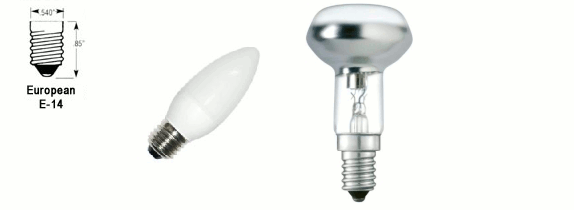
E14- aka “ minion» is one of the types of socles most used in everyday life.
Base E27.

E27- is the most famous and common type of base. This base is currently used not only in the production of incandescent lamps, but also other types of lamps, such as: halogen incandescent lamps, energy-saving compact lamps fluorescent lamps, gas discharge, etc. Please note that compact fluorescent lamps with a base E27 And E14 not suitable for use in circuits with electronic switches and dimmers.
Pin base G.
Pin sockets use a pin system for connecting the lamp to the socket. The numbers in the designation show the distance between the centers of the pins, and for a larger number of pins, the diameter of the circle on which the centers of the pins are located. Letters U X Y Z determine modification of the design. These caps are not interchangeable!
|
Distance between contacts, mm |
|
|
G5.3 GU5.3 GX5.3 |
|
Base G4
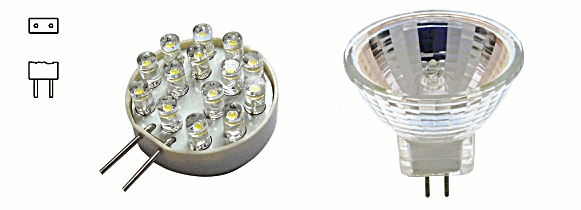
Base G4used in miniature halogen lamps with a voltage of 12V or 24V. The service life of halogen lamps is more than 2000 hours.
Base G5
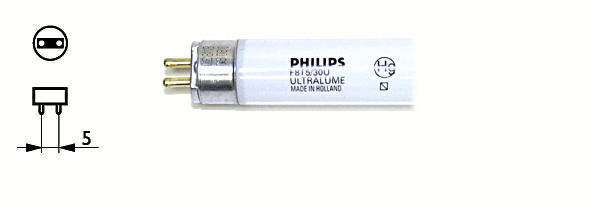
Base G5used in fluorescent tubular lamps with a bulb diameter of 16 mm.
Base G13
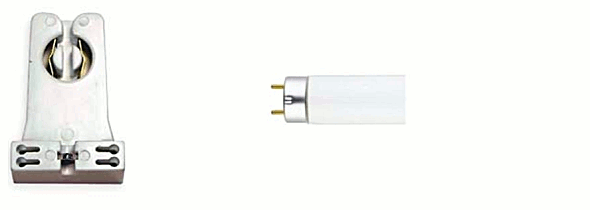
Base GU5

Lamps with base GU5.3(MR16) are used in everyday life for recessed lighting.
Base GU10
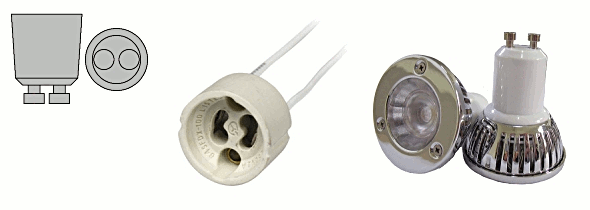
Lamps with base GU10 have thickenings at the end of the contacts for rotating connection with the cartridge.
Base with recessed R contact.
This type of base is used in some types of quartz halogen lamps, as well as in lighting fixtures high intensity. The numbers in the base marking determine full length lamps, mm.
Caround R7s
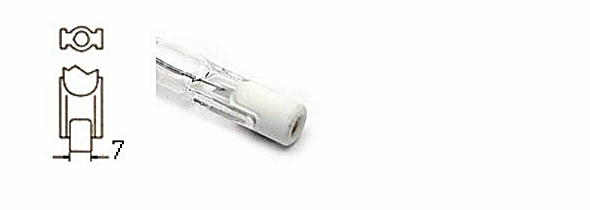
Pin base (bayonet) B.
The number in the marking of the pin base determines outside diameter base ( B9s, B15d, B22d) mm. Its feature is asymmetrical side contacts that position the lamp in the holder (socket) in a strictly specified way to focus the light flux, for example, in automobile double-helix low-high beam lamps or ship navigation lights.
In other countries, abbreviations are used instead of dimensions in millimeters:
BC - Bayonet Cap(Bayonet base) = B22d, Russian-language designation 2Ш22;
SBC - Small Bayonet Cap(Small Bayonet base) = B15d, Russian-language designation 2Ш15;
MBC or MBB - Miniature Bayonet Cap/Base(Miniature Bayonet base) = Ba9s, Russian designation 1Ш9;
Base BA15D.
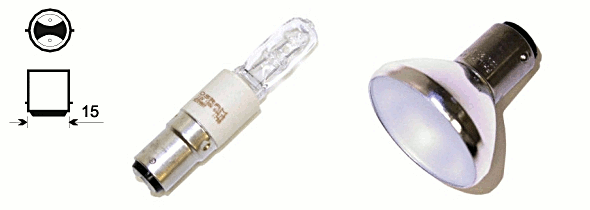
Soffit plinth S.
Base "S" (Festoon or Torpedo Lamps / Garland) - the contacts of the base are located on both sides, for example, like a glass fuse. The number in the abbreviation determines the outer diameter of the housing in mm ( S6, S7, S8.5). These lamps are often used to illuminate the car interior and license plate.
Bases SV7 and SV8.5.
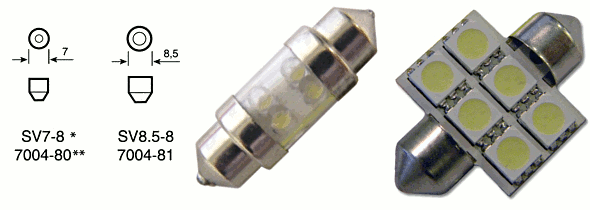
Lamps of this type are used in cars to illuminate license plates and interior lighting.
Focusing base P.
Base "P"(Prefocus type Bases / focused type base) - this type bases are used for film projectors, navigation lights, spotlights, film projectors, flashlights, etc. The prefabricated lens, which is located in the base, focuses the light flux in a given direction. The numbers in the marking determine the diameter of the focusing flange or part of the base.
Base P20d
![]()
Used in car high beam lamps.
Telephone socket T
This type of base is suitable for backlight bulbs, remote controls, mnemonic circuits, and so on. The numbers in the markings determine the external width in millimeters, which is measured along the contact plates. Now these lamps are used in various automation panels, mnemonic diagrams, and control panels.
Currently, there are many non-standard sockets used in various projection lamps:
- TO- base with cable connection;
- N - special plinth for xenon lamps.
In bases like W Contact with the socket occurs directly through the current inputs located on the glass base of the lamp. The numbers indicate the total thickness of the glass part with 1 current input. Next, enter the multiplication sign and the width of the base of the base in mm.
Previously, when buying light bulbs for home, we didn’t hesitate to take Ilyich’s light bulb and put it in our chandelier, but now there is a wide variety of lamps with sockets for different lamp bases. In the article we will look at the main types of bases and how to determine which lamp is suitable for us without taking the lamp itself to the store.
The base is the part of the lamp that is located in the socket and through which it passes electricity to the lamp.
Each type of base has its own designation, which is made up of certain letters and numbers:
- 1. The capital letter at the beginning of the designation determines type of base.
E— Edison threaded base (Edison/Edison);
G— pin base;
B— pin base (bayonet);
R- base with recessed contact;
S- soffit base;
P- focusing base.
- 2. The number after the letter determines base diameter or the distance between pins.
- 3. Small (lowercase) letters indicate the number of pins, contact plates or flexible connections in this basement.
s— 1 contact;
d— 2 contacts;
t— 3 contacts;
q— 4 contacts;
p— 5 contacts.
Threaded bases
They are one of the very first to appear and the most common in home lighting. The letter designation was received from its inventor Thomas Edison (Edison). The numbers following the letter indicate the diameter of the base in mm.
Lamps with E27 socket are well-known Ilyich light bulbs, but today they are also used for LED and energy-saving lamps.
Pin sockets
For this type of lamp, the first letter in the designation is the English G. To connect to the supply wires in the socket, both straight pins and pins with a thickening at the end are used. The number indicates the distance between the centers of the pins.

Additional designation by letters U X Y Z denotes the type of design. Lamps of the same size, but with different types of design, are not interchangeable.
Among these sockets, lamps with G23 and G 24 sockets stand out. These lamps are produced with starters located inside. 
Lamp sockets with thickening on GU10 pins are used in places of high vibration; by inserting them into the socket and turning, we secure them from falling out of the socket.
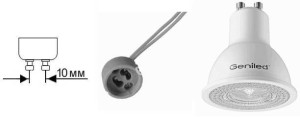
If you have seen unusual ring lamps in stores, then you should know that these use bases G10q. 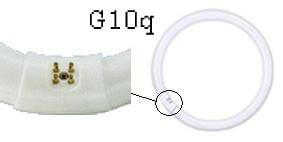
Much less common, but still found in home lamps, are bases with a combination of two or even three bases. To designate these socles, put a number corresponding to the number of socles in front of letter designation. For example 2G 10, 2G 11, 2G 13.

Pin (bayonet) sockets
This type of base is a modified type of threaded base. Only the role of the thread is played by the pins on the sides, due to which the lamp is fixed in the socket. Designated English letter V or Russian Sh ( В22d=2Ш22).The number before the letter is the number of contacts, after the letter is the diameter of the housing.
This type of base is used in cars. Due to precise fixation, such lamps can be 2- or 3-pin. For example, a lamp with 2 low-high beam spirals.
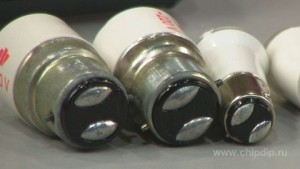
Foreign-made lamps with bayonet sockets do not contain a digital prefix, but are designated by the abbreviation:
BC - Bayonet Cap(Bayonet base) = B22d, 2Ш22;
SBC - Small Bayonet Cap(Small Bayonet base) = B15d, 2Ш15;
MBC or MBB - Miniature Bayonet Cap/Base(Miniature Bayonet base) = Ba9s, 1Ш9.
Base with recessed contact
Is it designated by the letters R7s? 7 is the diameter of the hole. The numbers after the letters indicate total length lamps in mm, such lamps are produced in lengths of 78, 118, 189, 254 mm. Used in various quartz devices and devices with high lighting intensity. 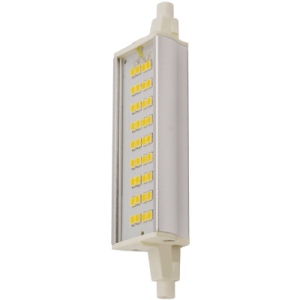
Humanity has been using various lighting lamps. Since their invention, they have undergone a number of significant changes and improvements. In this regard, new types of lighting lamp bases have appeared. This makes it possible to use them in a variety of lighting fixture models.
Types and designation of lamp bases
The socket is a structural element of the light bulb that allows it to be installed and secured in the socket. It is equipped with conductive contacts through which power is supplied. This structural element can be ceramic, metal or plastic. In addition, it ensures sealing of the flask filled with inert gas. Due to the variety of socles, it became necessary to designate them.
An example of such marking is the following letter designations:
- E - standard,
- G - pin,
- R - with recessed contact,
- B - pin,
- F - with one pin, etc.
The connecting part of the base has a certain diameter, indicated by numbers applied after the letter marking. The same numbers can indicate the distance between the contacts. After the numbers, letters can again be written indicating the number of contacts: s - 1, d - 2, t - 3, q - 4, p - 5.
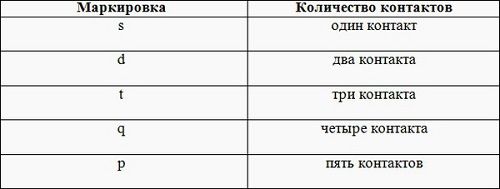
Some types of lamps have additional letter marking, applied after the first letter.
- A - means car lamp,
- V - the presence of a conical base,
- U - indicates energy saving.
Decoding lamp bases
An approximate interpretation of the base looks like this: E14U - corresponds to one with a threaded base with a diameter of 14 mm. Other types of socles are deciphered in the same way.
Explanation of the main types of bases:
Threaded (type E). Previously they were used for conventional light bulbs, and now - for energy-saving ones. The diameter of the base determines its name. For example, 5 mm refers to micro-bases, 10 and 12 mm are considered miniature bases, 14 mm is a standard “Mignon”. Next come small, medium and large bases.

Pin (type G). The scope of their application is quite wide; most often they are equipped with halogen and fluorescent lamps. The difference in the distances between the contacts may not be noticeable, but even 2-3 mm already matters when decoding.

With recessed contact (type R). Used in high-power lamps designed for operation at high temperatures. This category includes halogen and tubular quartz lamps, having small dimensions and weight. Explanation R7d means the presence of a pin socket with a diameter of 7 mm and two contacts. After the main marking, numbers are applied corresponding to the construction length of the lamp in millimeters.
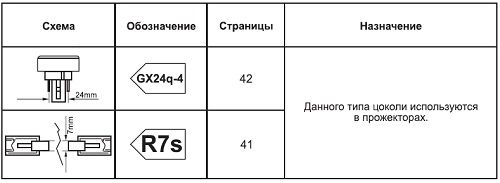
Soffit pin (type S). Located on one or both sides of tubular lamps. These luminaires are used to illuminate bathrooms, highlight mirrors or stage equipment. The digital designation in the marking corresponds to the diameter of the body. In some cases, this socket with a conical end is used in certain types of automotive lamps.
Focusing (type P). It differs from a soffit base in the presence of an additional dissipating platform. Used in flashlights, spotlights, film projectors and other equipment. The base has a prefabricated lens that directs the light flux into the right side. The numerical designations correspond to the diameter of the focusing flange.

Considering the bases of lighting lamps, it should be noted that there are lamps with general marking, without specifying the type of base. These bulbs are used in projectors and other equipment. Type installed base they are determined by the type of lamp itself.
Types of lighting bulbs
Each lamp uses a specific type of socket, into which only a lamp that has a suitable base can be installed.
For any type of socket, in our store, you can purchase the appropriate lamp.
We are ready to offer a full range from the world's leading manufacturers: Osram, Philips, Paulmann, etc.
We have in stock: incandescent lamps, energy-saving lamps, halogen lamps, fluorescent lamps, etc.
Below is brief information about lamp bases found in our store.
Plinths have their own designation system. It consists of several elements:
1) The first letter indicates the type of base:
E- threaded base (Edison)
G- pin base
R- base with recessed contact
B- pin base (bayonet)
S- soffit base
P- focusing base
2) The number indicates the diameter of the connecting part of the base or the distance between the pins.
3) Lower case show the number of contact plates, pins or flexible connections:
s- one contact
d- two contacts
t- three contacts
q- four contacts
p- five contacts
Threaded base (Edison).
Edison base- threaded system for quick connection of the lamp with the socket. Designation Ehh corresponds to the diameter in millimeters. Example: base E27 - threaded connection with a diameter of about 27 mm.
Pin socket - G
Denoted by the letter G. A pin system is used to connect the lamp to the socket. The numbers in the designation show the distance between the centers of the pins, and for a larger number of pins, the diameter of the circle on which the centers of the pins are located.| Type | Distance between contacts, mm |
| G4 GU4 GY4 | 4 |
| G5 | 5 |
| G5.3 GU5.3 GX5.3 | 5.3 |
| GY6.35 | 6.35 |
| G9 | 9 |
| GZ10 | 10 |
| G13 | 13 |
| G53 GU53 GX53 | 53 |
Note: The letters U X Y Z indicate modification of the design. Such bases are not interchangeable!
Separately, it is worth mentioning the plinths G23 andG24 . They have a starter located inside:
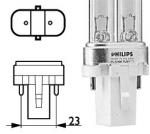
For lamps with a base GU10 There are thickenings at the end of the contacts for rotary connection with the cartridge:
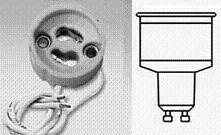
Fluorescent ring lamps use a base type G10q:
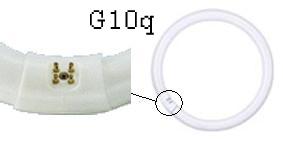
Sometimes a plinth is seen as a combination of two or more similar plinths. In this case, the number of combined bases is indicated before the general designation: 2G 11, 2G 10, 2G 13:

Base with recessed contact -R
Please note that after r the designation of the base R 7s, the numbers are indicated: 78 or 118. They indicate the total length of the lamp in mm.
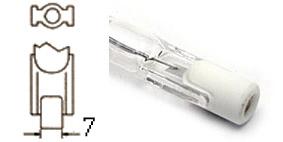
Pin base - IN
Denoted by the letter B. The base body has pins for connecting to the socket.
Example: В22d- pin base with a case diameter of about 22 mm. , with two contacts:
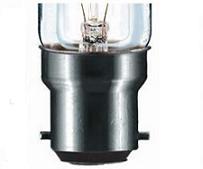
Soffit plinth - S
S 19 And S 14s shown in the figure.
![]()
Focusing base - P
P 14.5s - focusing base with one contact, case diameter (orienting part) 14.5 mm.

In some cases, instead of the base type, the lamp type is indicated.
MR16(numbers may vary) - standard size of halogen incandescent lamps with a reflector. Typically, a pin base is used (g9, g4, g23, etc.).
R 50(the numbers show the diameter of the lamp) - the standard size of reflector lamps. They serve to create directional light. In most cases, the base is threaded - e27 or e14.
2D- These are compact fluorescent lamps. Lamp bulbs are made in the form of two arcs. Base G 10 q or GR8.
Flask lamps
They are lamps in the form of a glass tube. They differ in diameter and type of base and have the following designations:
T5(diameter 5/8 inch=1.59 cm),
T8(diameter 8/8 inch=2.54 cm),
T10(diameter 10/8 inch=3.17 cm),
T12(diameter 12/8 inch=3.80 cm).




